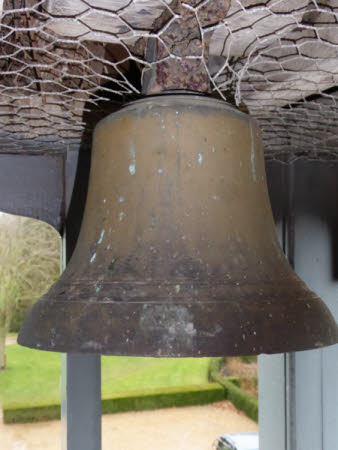Bell
John Rudhall
Category
Metalwork
Date
circa 1820
Materials
Bell metal, iron, wood.
Measurements
700 x 380 x 400 mm; 254 mm (Diameter); 12 kg (Weight)
Place of origin
Gloucester
Order this imageCollection
Coughton Court, Warwickshire
NT 1961378
Summary
Bell in an open wooden turret above the archway leading into the stable yard.The bell was hung as an estate call bell or alarm which was rung by a rope hanging down on the North side of the archway. The bell is hung with swing-chiming fittings but it as the crown-staple has broken it has no clapper and so it is no longer rung. The bell is a ‘brassfoundry-type” sand casting with a peg argent (i.e. handbell type). It has no external inscription or marks. There are shallow mouldings on the crown and between the low waist and soundbow. There is, however, an inscription cast on the surface inside the bell. This is just the maker’s name in capitals and small capitals, I Rudhall. The maker was John Rudhall of Gloucester (fl.1786-d.1835).
Full description
Bell in an open wooden turret above the archway leading into the stable yard. The turret stands on top of the roof. Its square base is leaded. Above, each side has pairs of openings with ogee-headed tops. The turret has a leaded cap topped with a weathervane in the form of a running fox. From below one can see from the ground right up through the roof and into the turret. The inside of the bell is also visible from the ground. The turret is supported on stout wooden beams within the roof of the archway. On the North side of the archway can be seen the wooden pulley and iron cleat for the bellrope The bell was hung as an estate call bell or alarm which was rung by a rope hanging down on the North side of the archway. The bell is hung with swing-chiming fittings but it as the crown-staple has broken it has no clapper and so it is no longer rung. The bell is a ‘brassfoundry-type” sand casting with a peg argent (i.e. handbell type). It has no external inscription or marks. There are shallow mouldings on the crown and between the low waist and soundbow. There is, however, an inscription cast on the surface inside the bell. This is just the maker’s name in capitals and small capitals, I Rudhall. The maker was John Rudhall of Gloucester (fl.1786-d.1835). Bells with internal markings are surprisingly rare, but John Rudhall is known to have cast several other sand-cast bells of this type. The bell (which weighs about 12kg) is hung to swing between two parallel beams jointed to the square of timbers in the base of the leaded cap of the turret. There are circular cut-outs in the timbers in the end of the pit to allow the bell to swing. The fittings include a wooden stock with drive-in gudgeons, an iron chiming lever (with the remains of a rope), and a collar round the stock with a bolt through the peg argent of the bell. The crown staple has broken off. There is no clapper in the bell (is it still around somewhere else on site?)
Provenance
Indigenous fixtures, fittings and discarded contents acquired when the National Trust took ownership in 1946.
Marks and inscriptions
Inside bell: Inscription cast on surface inside the bell. This is the maker's name in capitals and small capitals, I RUDHALL.
Makers and roles
John Rudhall, maker
